36 Hours on Ireland’s Beautiful Dingle Peninsula
im Ferri
A light rain started falling as I made my way to Dingle, Ireland, the main town of the westernmost peninsula where Ireland thrusts itself out into the Atlantic.
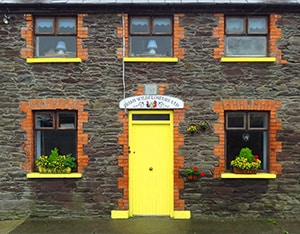
A house in Dingle, Ireland
Over the years, I had heard many raves about the beauty of Dingle, and I was determined to both see and judge it for myself.
I was driving up from the Ring of Kerry near Killarney, a two-hour journey on a circuitous route across beautiful countryside. My immediate destination was the Fiuise Bed and Breakfast in Dingle town, a small fishing port and the main town in the area.
“Fiuise” means fuschia in English and I couldn’t help but think how odd a name in a country so green. Despite the color disparity, the Fiuise turned out to be the beginning of a wonderful 36 hours on the Dingle Peninsula.
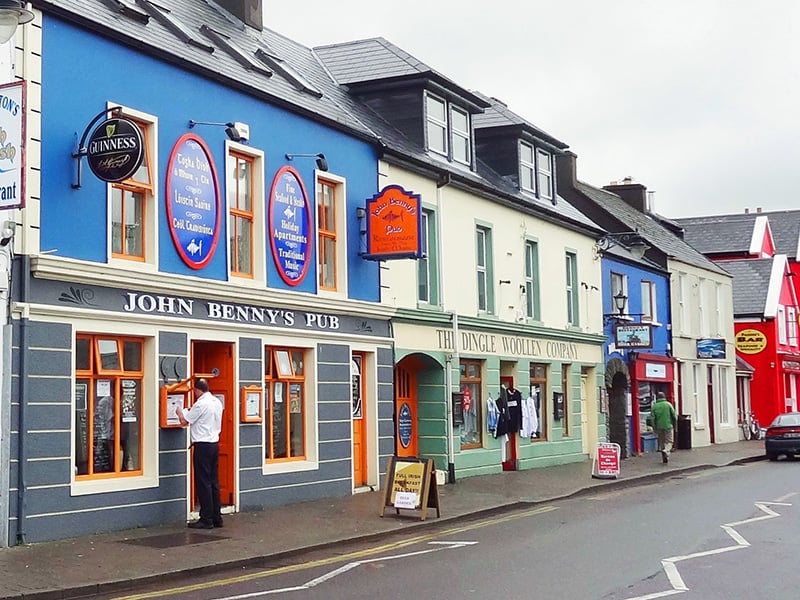
Shops and pubs in Dingle town
Hotels in Dingle, Ireland
I found the Fiuise B&B on the far side of Dingle Harbor, just a few minutes from the center of town. It was the home of Donal and Eileen Carroll who, like many of the Irish, had added to, or modernized, a section of their home for accommodating guests.
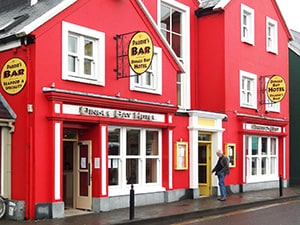
A hotel in Dingle town
In traveling all about Ireland, I found the Irish B&Bs to be wonderful places to spend an overnight or two. Donal and Eileen’s home was very comfortable and highly rated online, and Donal and Eileen very accommodating.
There are many hotels in Dingle town and scattered about the peninsula. Some, like the Fiuise, are in B&Bs in homes while others are actually small hotels. You’ll also find them on the second floor of some pubs in Dingle, although one can’t help but wonder how you’ll ever get any sleep with the noise and music from below.
A search on TripAdvisor, Booking.com, and hotels.com will provide plenty of listings. Book well ahead in the summer season since rooms go quickly then. There’s plenty availability in other seasons and September is a great month to travel about Dingle.
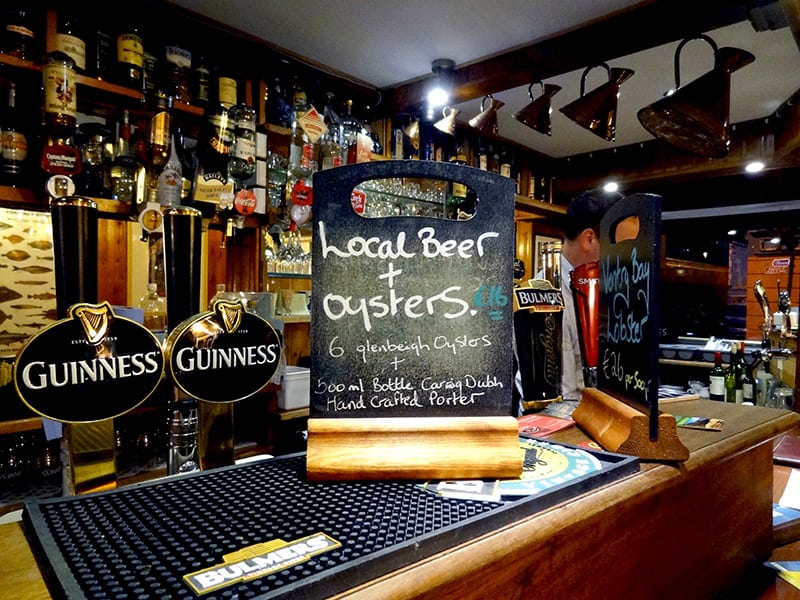
Ashes Pub in Dingle
Dingle’s Restaurant and Pub Life
Not long after my arrival, I inquired about a good place in town to have dinner that evening, and Donal and Eileen told me of a restaurant they enjoy, as well as three pubs that play traditional Irish music. Donal then insisted on driving me into town to show me exactly where they were.
Nonetheless, when I made the drive into town that evening, I got lost and couldn’t find the restaurant and only one of the pubs.
Instead of wandering about in search of the restaurant I decided instead to dine at Ashes, a pub/restaurant that had a wonderful menu, much of it focusing on seafood, a specialty of the region.
Ashes was a cozy little local place, and on the bar I quickly spotted a small chalkboard touting the evening’s special, “Glenbeigh Oysters and Carraig Dubh hand-crafted porter beer” for €16. I opted instead for the local scallops, which were exceptionally fresh and tasty, with pork belly.
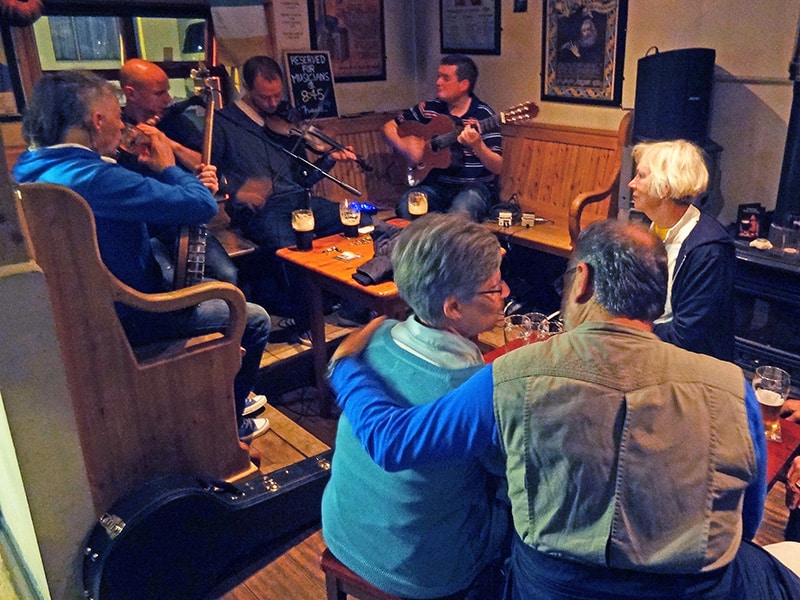
Pub music in O’Sullivan’s Courthouse Pub, Dingle
Across from me were a couch and a table where a couple was dining. On the wall behind was a large photo showing the late movie great Gregory Peck and his wife sitting in the same spot chatting with local folks over dinner.
After dinner, I stopped at a nearby pub called the Courthouse, where traditional Irish music was being played to a small crowd ranging in age from their early 30s to their 70s. One of the patrons gave me the directions to Foxy John’s pub, a combination of pub and hardware store.
Donal had told me about Foxy John’s earlier; it is one of the few remaining pub-hardware store combos left in Ireland despite there being so many in the ‘40s and ‘50s. I walked over to Foxy John’s where I nursed a beer as I took in the ambiance. I soon headed back to the Fiuise since I knew I had an early morning on the horizon.
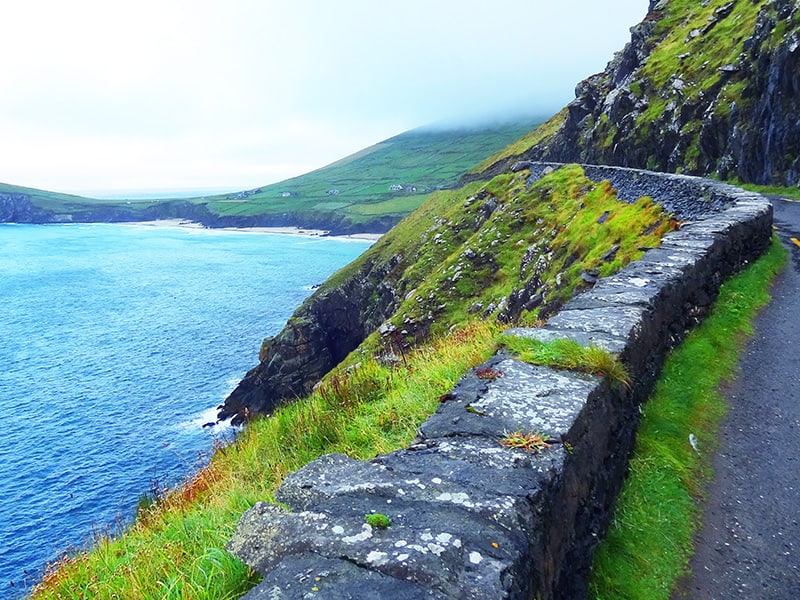
The road along Slea Head
A Spectacular Drive
After a good breakfast, I set out early towards Slea Head on a drive around the western end of the peninsula. This was the journey so many travelers rave about, the drive along the road that hugs the beautiful and dramatic coastline.
A light mist started falling again– “it keeps everything green,” said Eileen – as I set off to make my way along a coastal road walled by hedgerows. Every once in a while I caught a glimpse of the ocean through a break where cows were let out into the pasture. Not long after I also met a few of them grazing alongside the road.
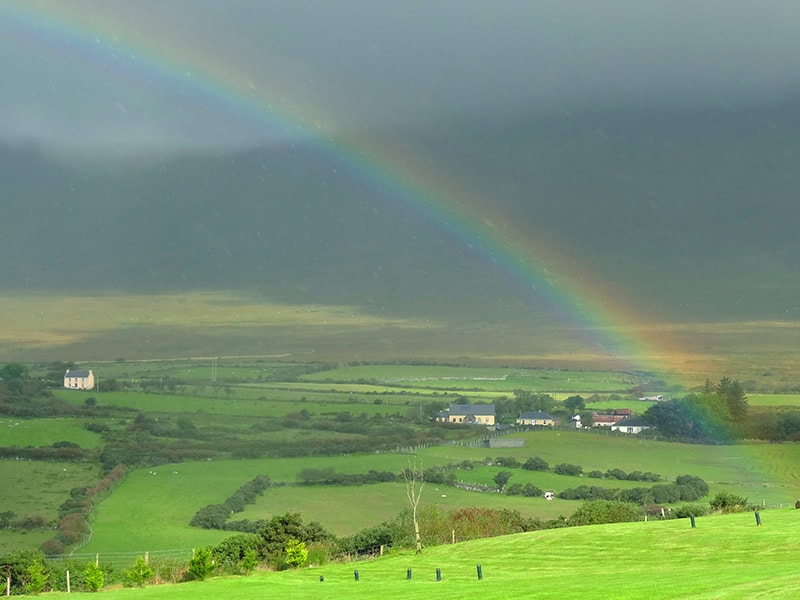
A rainbow a day
The hedgerows disappeared as I neared Slea Head, the most dramatic part of the route. The road had been slowly climbing upward, and I was now driving along cliffs plunging into a roiling surf far below. The morning fog was slowly burning off, giving a softness to everything. On the inland side of the road, large rectangles of pasture covered the hillside, their stonewalls creating neat little frames for myriad sheep and grazing cattle.
There wasn’t another car or person anywhere in sight, only the occasional sheep. I parked my car and walked along the road for a short while, mesmerized by the beautiful scenes on each side of the road. It was then the early morning sun began poking its way through the clouds here and there, slowly burning the fog off the weathered shoreline.
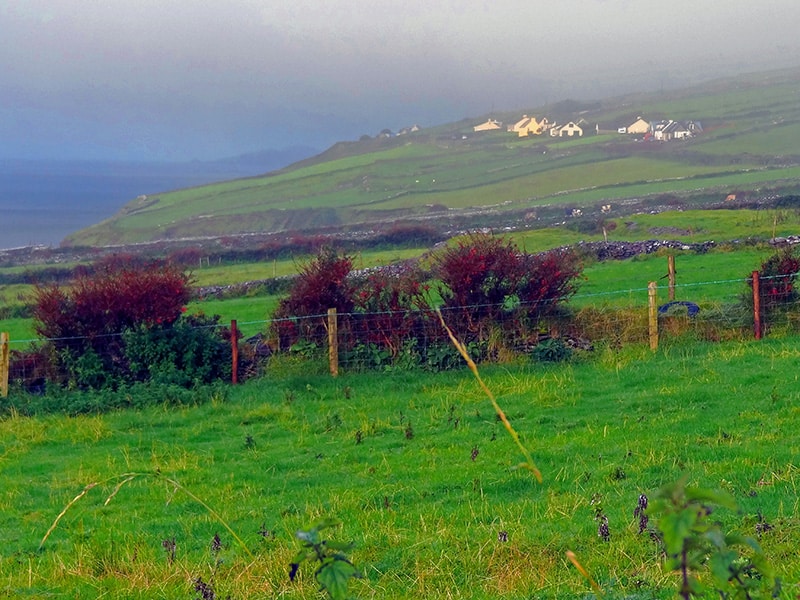
The view towards Coumeenoole along Slea Head
The Incredible Beauty of the Dingle Peninsula
I continued along the road, still not seeing another car or a human.
What I did see was a clochán, an ancient drystone beehive-shaped hut, one of many around Dingle thought to have been built in the 12th century. The sign on the road promised it was only a “two-minute walk” to the huts from the small parking area, the same promised for the original “Irish Famine Cottage” I had passed earlier.
I stopped only briefly to look at one of the huts and then continued my slow drive along the little coastal road. I finally then did see another human, a farmer high up on the hillside entering a pasture to tend to his sheep.
I was mesmerized by the brilliant greens that contrasted with the shifting colors of the sea, which raced from steel gray to light blue to aquamarine as the sun poked its fingers through the clouds.
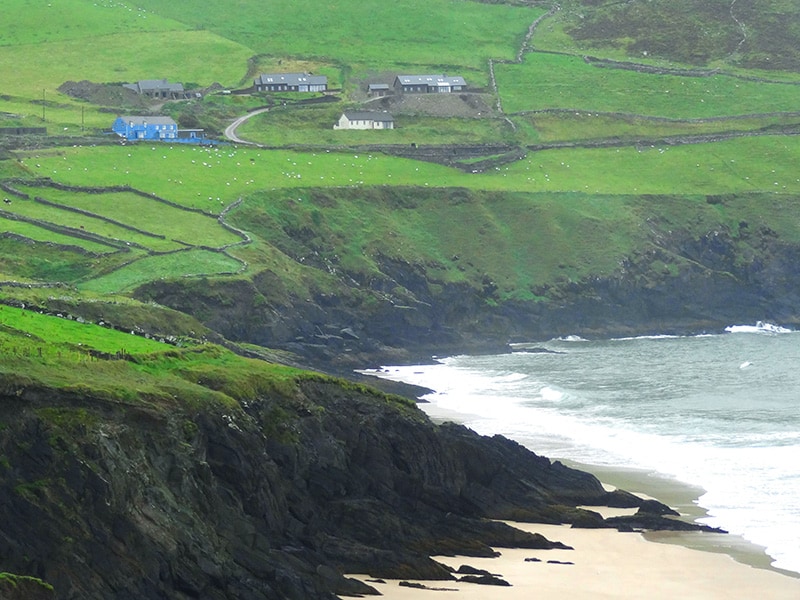
Tig Slea Head on the DIngle Peninsula
Ryan’s Daughter
Donal had told me of the hard wind that blows here in the winter, and as I rounded the head, I got a gusty and blustery forewarning of it. Then, as I came around a bend in the road, I saw a small plaque and pulled over to read it.
It celebrated the making of the epic 1970 movie Ryan’s Daughter, filmed on the Dingle Peninsula. The beauty of the area, captured on film for a worldwide audience, propelled Dingle to international prominence. It was the film that forever changed the fortune of the peninsula.
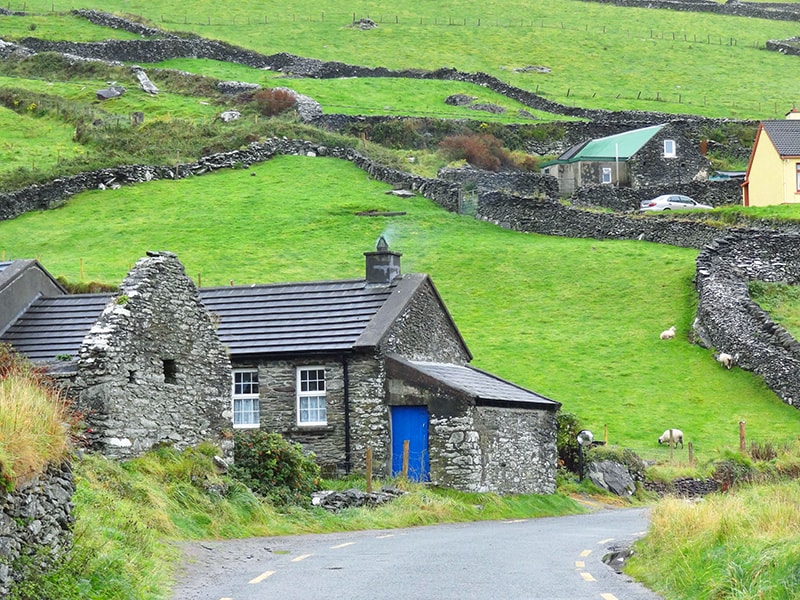
Homes near Tig Slea Head on the Dingle Peninsula
I stood there in amazement, looking out on one of the most beautiful spots I’ve ever seen in Ireland. Gulls hung motionless in the wind above my head while I looked out on cliffs that plunged onto a snippet of a wave-lashed beach. I was amazed that although the Dingle Peninsula was so relatively close to the Ring of Kerry near Killarney, it was so very different in its beauty.
Sheep with the bright blue markings on their backs were scattered all over the hillside. In the distance stood the Slea Head Café and Arts Shop, painted a bright blue that matched the color of the markings on the sheep, with cottages and homes dotting the hillside beyond. It was a scene ready made for an Ireland travel advert.
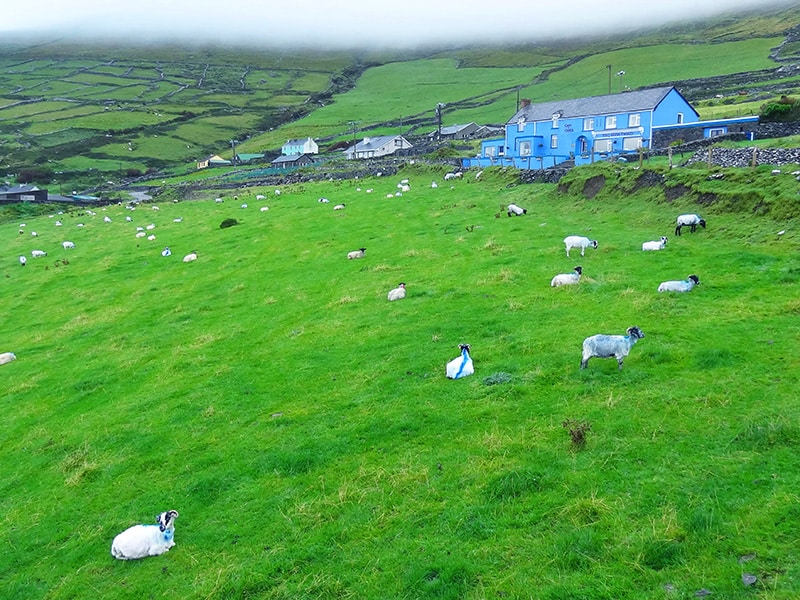
Sheep grazing at Tig Slea Head
I stood there for several minutes absorbing the beauty of my surroundings, watching the sheep as they slowly began grazing in my direction as they became more comfortable with my presence.
I couldn’t linger as long as I would have liked, though. I reluctantly returned to my car and got back on the road, which soon turned inland and headed over the hills back to Dingle.
All along the way, I kept thinking of the beauty of the landscape I had just driven through. And also that I now understood the reason for all those raves about Dingle.
If you go:
Tourism Ireland
345 Park Avenue
New York, NY 10154
Tel. (800) 223-6470
http://www.ireland.com
345 Park Avenue
New York, NY 10154
Tel. (800) 223-6470
http://www.ireland.com



0 Comments